White hydrangea in the garden. Hydrangea: cultivation, landing, care, pruning, reproduction - secrets and accents. Legend of Hydrangea
Hydrangea is a long-term semi-staple, sometimes reaching a height of one meter. The leaves of the egg-shaped shape, a length of 12-14 cm, and are on the stem parallel to each other. Bright - white, pink and red - flowers are assembled in "umbrellas", reaching sometimes 35 centimeters in diameter. This chosen-bought plant loves moisture. There are several types of hydrangea, each of them demonstrates the uniqueness of the grade. Take the following:
- What subspecies of hydrangea are relevant?
- Basic rules for growing hydrangea;
- How to care for Hortensia in the house?
Families blossom
Hydrangea bush is able to release from one to seven major spectacular inflorescences located on the most tops of the shoots. As a rule, the smaller their number, the themselves more and more beautiful. This shadowed plant is used to landshaning the interiors of any destination, decorating winter gardens, ornamental vases and flower beds in the winter-spring period. True, it is planted only in the southern regions of the country.
The bush begins to bloom in February, but the process is gaining intensity at the end of March-early April. The flowering period of one bush is one and a half or two months. At this time, the plant is better sharpened, and if the flower is grown in the room - transfer to the windows of the North side. The straight rays act negatively.
Council. Although the hydrangea is garden - a perennial, it blooms better only in the first year, so many gardeners advise to change the plants every spring.
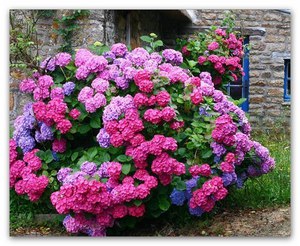
What subspecies of hydrangea are relevant?
This flower is derived in several varieties, differing among themselves the size of the bush, coloring and form of flower baskets, behavior and some other features. Hydrangea largest is the only inflorestection on last year's branches, its floral kidneys reach maturity only in autumn. And the cherry hydrangea is a long-term liana.

Miscellaneous variety is a long-lived, it can exist in one place for about 40 years, forming a tree-like bush. Unlike large, it is very cold-resistant. But landing and caring for Hydrangees by Miscellane, the tree, or other variants almost the same. All of them unites the love of moisture and shadows, the need for soil looser and mineral feeding.
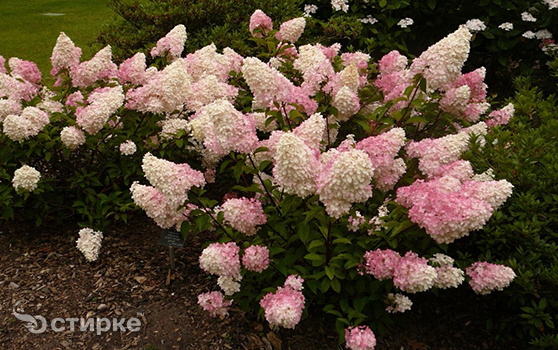
Basic Rules of Growing Hydrangea
To multiply the flower, from the root shoots of the plant harvesting herbaceous cuttings and installed on the tramp. It is optimal in the third decade of January or February. The cuttings planted at this time will have time to form small bushes in three or four escapes with affected byproof kidneys, suitable for disembarking next year. If you make landing later (in March or April), you can only get single-way seedlings.
Stems for reproduction are cut from the very base. Billets should have -3 interstitial length 7-8 cm. The leaves available on them are shortened at half or third, and the pair of the lower - is removed at all. The straight cut is made by 3-4 mm below the interstice.
Council. It is not worth cut cuttings from the stems much higher than the root. Of these, they can get a sapling, but in the already the process of its formation they can bloom, and it will hurt them.
Finished cuttings are planted into the substrate - a mixture of peat and sand - by a distance of 4-5 × 1.5-2 cm. The best temperature for rooting is 18-20 ° C, and air humidity is 75-80%. On the amusement of growth, besides the first months of life, the plants need to shade. But you do not need to cover the glass - they can bend and die. The rooting occurs after 3.5-4 weeks, if the landing occurred in January, or after 2 weeks from the February Chernok.

After 5-6 weeks, there are already well-rooted sprouts from all over the ground planting a pot with neutral acid peat, where they are waiting for the end of spring frosts, after which they are waiting for them, with all the contents of the vessel, plant in the ground at a distance of 30 × 40 cm and grow to autumn. At the same time, 0.5-1 kg of peat is added to all pits. Caring for hydrangeas during this period consists of frequent watering, loosening of the Earth and the removal of weeds. In October, when the cooling begins, the hydrangea is beginning to dig and move to a greenhouse, where seedlings will be stored in sleeping form until the end of winter.
Landing and caring for hydrogen hinges - sufficiently simple processes. After landing in the soil (March-April), it needs irrigation and darkening, removing weak and roasting shoots. Also, this plant, like all types of hydrangeas, needs to mulch the soil, so that no moisture leaves. Cut in the roots of the pigs can be used to reproduce hydrangea cuttings in summer. In addition to the shilling, the hydrangea can be multiplied by the division of the bush or a gag.
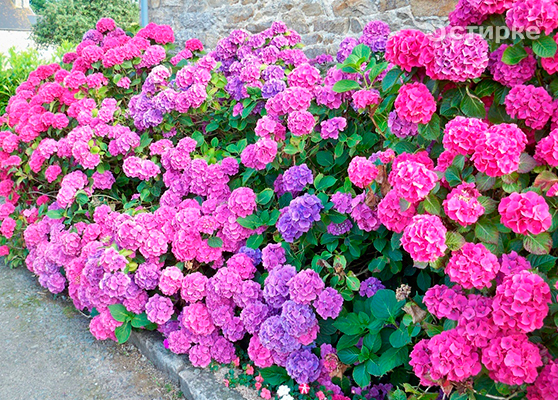
Hortensia care errors
Although this plant is quite unpretentiously, some gardeners admital, as a result of which a strong bush does not bloom. To figure out why the hydrangea does not bloom, you need to carefully check whether all the nuances of the care are taken into account.
- A sufficient amount of moisture.
- Well-developed root system. Sometimes you need to give the plant to graze and only then expect flowering.
- Acclimatization. Some bushes simply do not have time to grow flower kidneys, they lack warmth or light due to the unsuitable climate.
- Pruning the upper part of last year's branches. Some classic varieties produce flowers only at the ends of the shoots that grew up last year. Making a shrub trimming, you need to follow, so as not to damage and not destroy the flower kidneys.

How to care for Hortensia in the house?
A special subspecies of hydrangea is home optionwhich is grown in the pots on the windows. He is much less than his garden fellow, but if you organize proper care for Hydrangees at home, you can get wonderful large and bright inflorescences.
Like some other varieties, the most beautiful color plant boasts only in the first year of the "adult" life. Then the stems are pulled and deformed, and baskets decrease in size. To correct the situation, the hydrangea is regularly rejuvenated - spread vegetatively. With miniature room flower It should be done much easier than with large primer representatives.
Basic room care at home is the same as behind the rest. It is necessary to provide it with a sufficient amount of moisture and lighting, do not forget to feed the superphosphate, ammonium nitrate or organic fertilizers.
Currant - is in second place according to the degree of propagation in industrial planting after strawberries. This is due to the whole range of factors, it is frost resistance and drought resistance and ease of breeding and low cost of planting material, coupled with a large number of varieties. However, there is a currant abundance of diseases and pests. Today we will talk about one of these pests, about the Galovic Tel, which inflicts a rather tangible damage.
In nature, these impressive and beauty, and the dimensions of the giant one of their views cause admiration. Even in the garden form of elms - luxurious woody for very large sections. It is not surprising that elms that can be grown at home always seem to be a small miracle, a plant is really exclusive. The art of bonsai's art helps "tame" ancient beauties, while keeping the key features of these trees - a beautiful silhouette and unusual foliage.
Fish Souffle - the dietary recipe for which you are with ease of becoming a gentle souffle from the boiled pollock, cod or heck. Of course, sitting on a diet you can not waste time on the preparation of sophisticated eats, but it will agree, boring. It is necessary to indulge and teach themselves that the dietary food should be not only useful, but also delicious, beautifully cooked. Low-fat marine fish is loved by all nutritionists, and in the boiled or baked form - especially.
The standard of decorative and pomp flowering, magnificent garden rhododendron for many gardeners remains only a dream. The reputation of the plant exclusive spawned a lot of rumors and the complexity of cultivation, and about low winter hardiness. And none of these rumors is justified, as well as the myth that Rhododendrons cannot be propagated by himself. Rhododendrons can be grown from a cutlery, a grain and even from seeds, receiving a luxurious blooming shrub at minimal costs.
Petrushka is a universal green culture used in the raw form in salads, and in dried as seasoning. It belongs to this culture to the genus of grassyous twilight and belongs to the family of umbrella. The very first mention of this green culture was found by archaeologists in the ancient Egyptian scrolls. She was so revered and in demand that many legends were told about her appearance. The most popular usually parsley sheet.
The homely chicken roll in the oven made of chicken breast, hammers and hearts to cook at all. The main chip of the recipe - spices and seasonings. Fennel, smoked paprika, garlic and dried chili are successfully combined with a church, and dried carrots will decorate the product not only taste, but also add beauty. New Year's recipes do not have to contain the rarest ingredients, often from the most banal products a culinary masterpiece is obtained if you cook with love.
Cold northern rooms are considered rarity, but insufficient heating is rather a bonus for growing plants than the deficiency. It is in such rooms that can arrange the perfect rest period for many cultures. And although the level of illumination still makes it carefully to pick up candidates, difficult in landscaping the cold rooms cannot be called. It is cold called rooms, temperatures in which winter remains within the range from 10 to 15 degrees.
Curd Muffins with Cucats from pineapples, raisins and bright confectionery sprinkle will decorate your sweet festive table and do not take a lot of time cooking. Muffins are made in lush, wet, a lot of stuffing in them. Such a festive baking is convenient to put in a beautiful box and take a visit with you. Madfins, prepared on this recipe, can be stored 2-3 days in a hermetically closed container. For baking it is convenient to use silicone forms.
Lupine belongs to the family of legumes and a person grows by his millennia. There is information that the first seed of lupine into the soil has been thrown for four thousand years ago. Its seeds contain half of the protein and about a third of the oil. Animals with a large hunt eaten both seeds and all the above-ground mass of Lupine, from which they quickly add in weight and rarely sick. At the moment there are about two hundred species of Lupine. We will talk today about three of them - annual species.
Alpine slides - an indispensable element of garden design. And it's not just the imitation of a special charm of mountainous corners, but also in expanding opportunities to grow a plant in the garden, preferring stony, light and dry soils. In symbiosis with a stone, the best of decorative deciduous sprinkled plants completely disclose their beauty. After all, it is on the mountaineers that enduring soil workers are fully exhibiting the beauty of both their textures and the color.
Cutlets in the oven - a dish that is simply cooking, and small culinary tricks allow you to make it not only delicious, but also beautiful. Cutlets with Toping and Cherry Tomatoes You will have time to prepare in less than an hour, you see that for a meat dish in a brass cabinet is quite a bit. Meat for cooking Cottable will suit anyone - turkey, chicken, calf, but always remember that delicious cutlets get their good meat. It is not worth saving on this.
Protection stimulants are used to stimulate growth and development, as well as for the actual formation of the root system at the cutting. Of course, the stimulants of the root formation cannot be called the wonderful drugs that can "resurrect" a weird stalk and lead to the formation of roots on it. But if you clearly follow the timing of the cuts of shoots, cutting them on the cuttings and landing in a greenhouse, the stimulants of the root formation will help.
Externally more reminiscent of the Mirates, their close relative of Eugene cannot boast of the same popularity. Thick foliage, lightness of molding - the main pride of this plant, thanks to which it is used for bonsai or room topiary. But still most in the room Eugene attracts gentle, almost pastoral flowering. In addition, this magnificent plant belongs to not too complex in growing cultures and real long-livers.
The home spray turns out to be more delicious shop - this is a fact! Ambassador to the thief at home - the process is simple, agree, - put the fish in the brine will not be. In this recipe, I spent a few more time, since the fishing machine cleaned from the heads and internships and poured oil. It turned out something similar to Anchovs. Fish fillet ripe well in oil, looks very good on a piece of fresh rye bread, with butter and green and green.
The tulip fever, which began in Holland half a thousand years ago and capturing the whole world, continues today. There is not a single flower or gardener who would not have dreamed of expanding their collection of tulips varieties and who would not be familiar to this special bulbous star. Tulips do not need a presentation, but nuances and subtleties from this in their cultivation, it does not become less, as, however, and the options for their use in the design of a flower bed and a garden.
The thermal-loving shrub with huge hatches of the inflorescence came to Europe from Japan in the XVIII century. For a long time, the hydrangea remained a home plant, but also gardeners amateurs, and breeders of the old world professionals worked hard to bring out this fragrant shrub in their gardens. TO eND XIX. The century work was crowned with success, and plant fans got frost-resistant varieties, perfectly feeling themselves in a moderate climate.
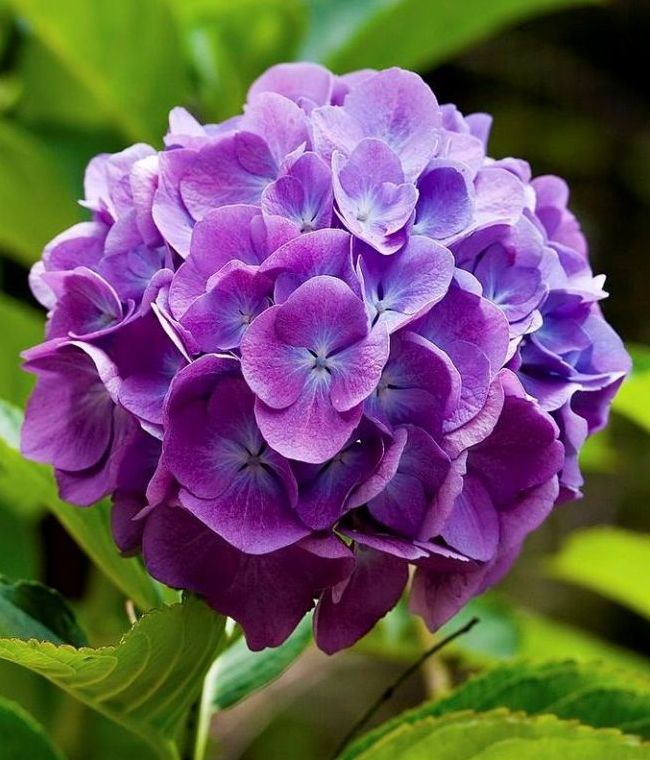
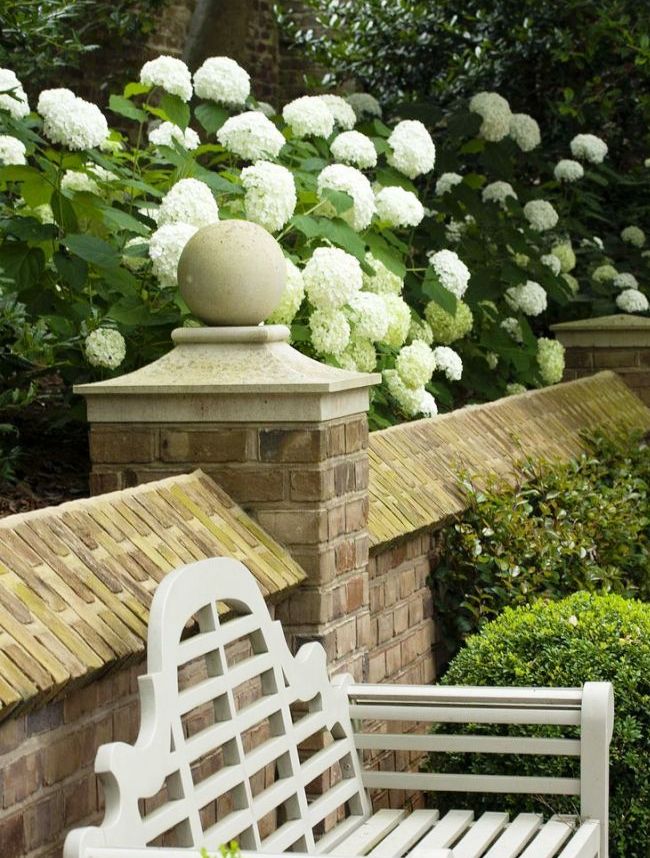
![]()
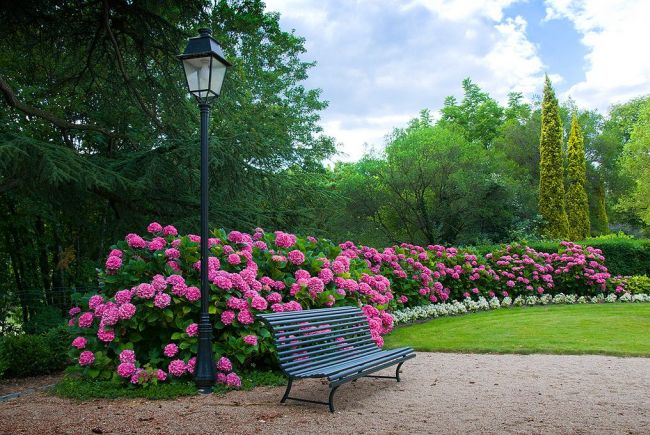
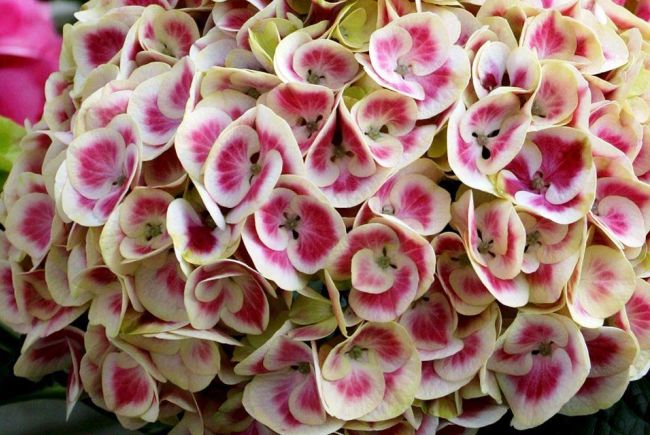

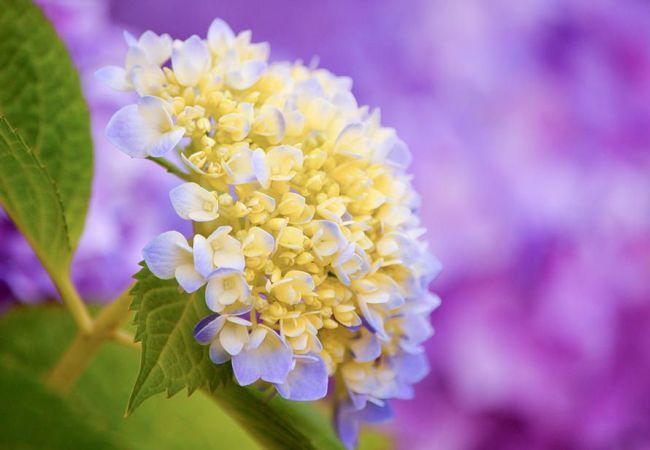
Types and varieties
The hydrangee family has about 100 species. However, not all of them are suitable for planting in the country area and in the garden of our climatic zone. We found out what types and varieties of hydrangea for the garden are perfectly leaving and successfully growing in our latitudes. Let us dwell on the most popular plants among the gardeners. These include: Miscellaneous Mounting Hydrangea (WHITE MOTH, Floribunda, Unique), Hydrangea Tree (Grade Anabel and Snow Ball), Pillya Hydrangea (Bluebird Grade (Blue Bird)), Sannese Hydrangea, Hydrangea Cherry, Doltenna Dorbal (Snow Queen and Snow Flake), and the most common hydrangea hydrangea, or large-scale (quadricolor varieties, Lilacina, Nigra, Grandiflora, Perfecta, Altona). Little details about each.
- Miscelred - White-cream flowers collected in the inflorescence of the pyramidal shape, in the flowering process take the pink shade, which by autumn acquires the lush of the shades. It grows very quickly, so it requires constant trimming. Gives long blossom in the fall.
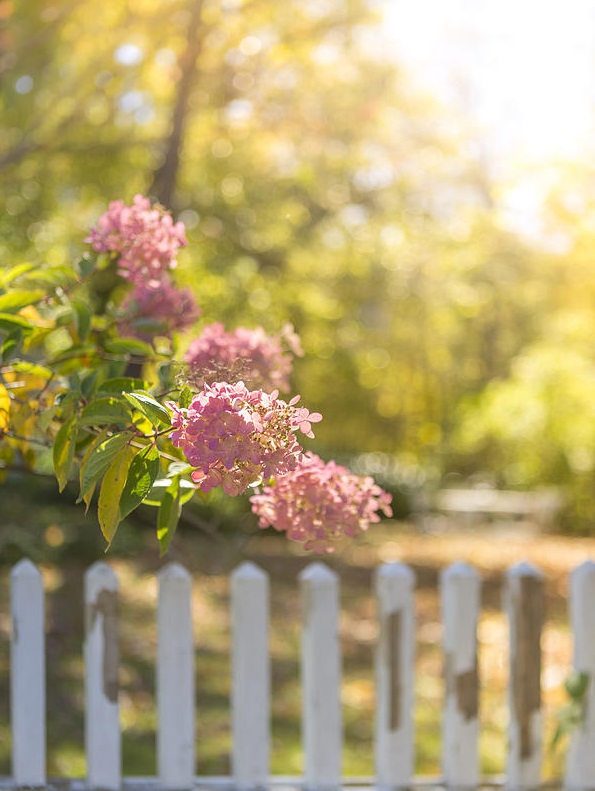
- Tree- Visually resembles Kalina, white-cream, spherical inflorescences. It grows up to 2.5 m, the leaves are pointed, the flowers are tightly adjacent to each other. The flowering continues from July to September.
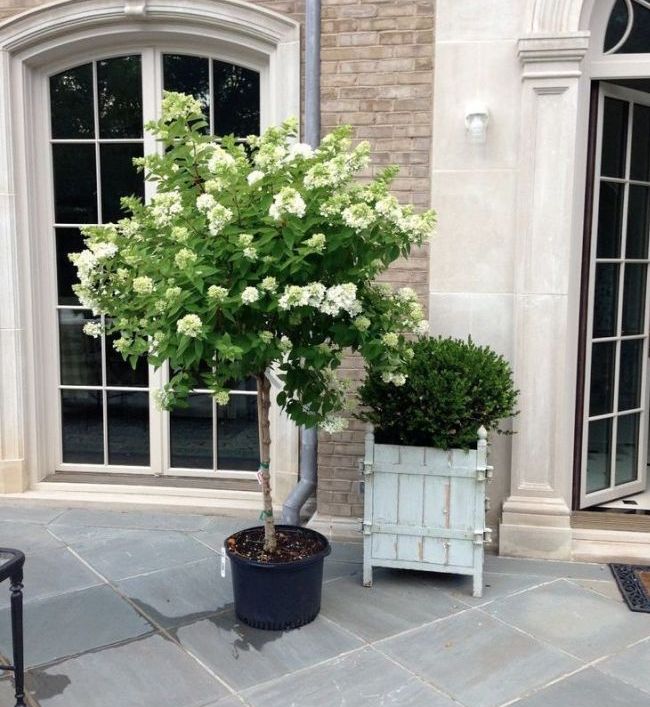
- Pillya- This species loves the sun, relatively low (up to 1.2 m), especially the beautiful Bluebird variety, with gentle blue flowers, which make up a flat-shaped ball. Long flowering period (from June to September).
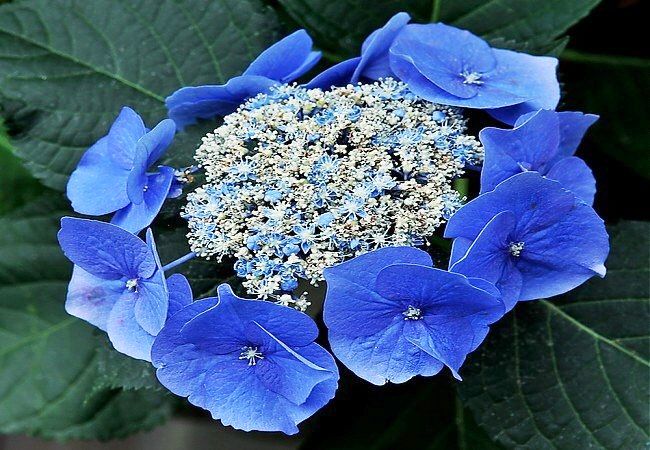
- Sarzhen.- Leaves with velvet surface, inflorescences are very large (up to 30 cm in diameter), with exquisite transitions of color, from a saturated violet inside and pale-pink cuts around the edges. May grow up to 4 meters. The beginning of flowering falls at the end of summer.
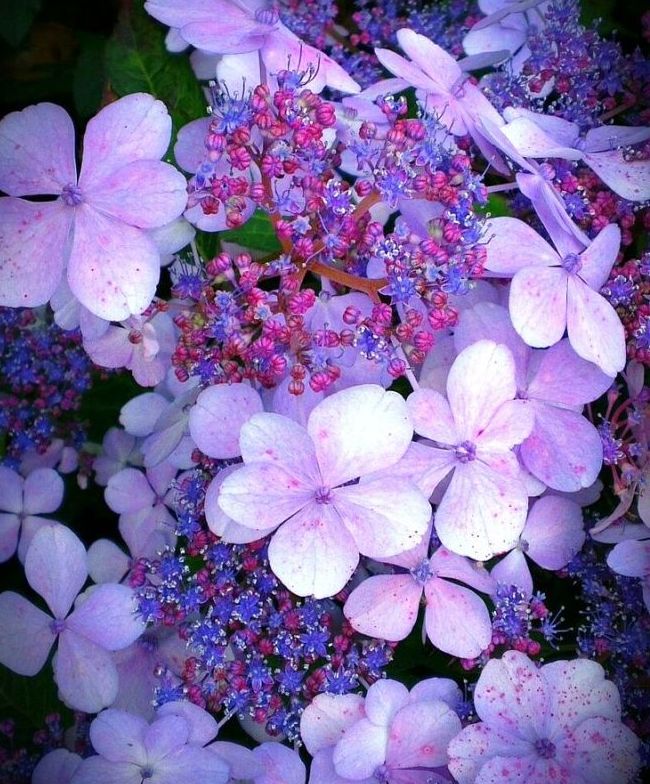

- Cherry - refers to vying See, Dark green leaves, Red-brown stems, prefers halftime, blooms a few weeks at the beginning of summer.
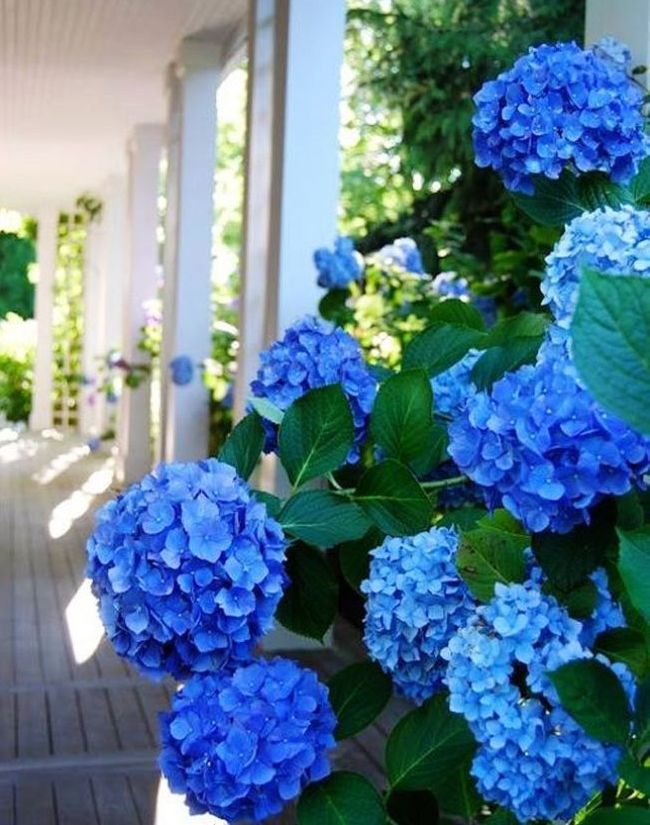
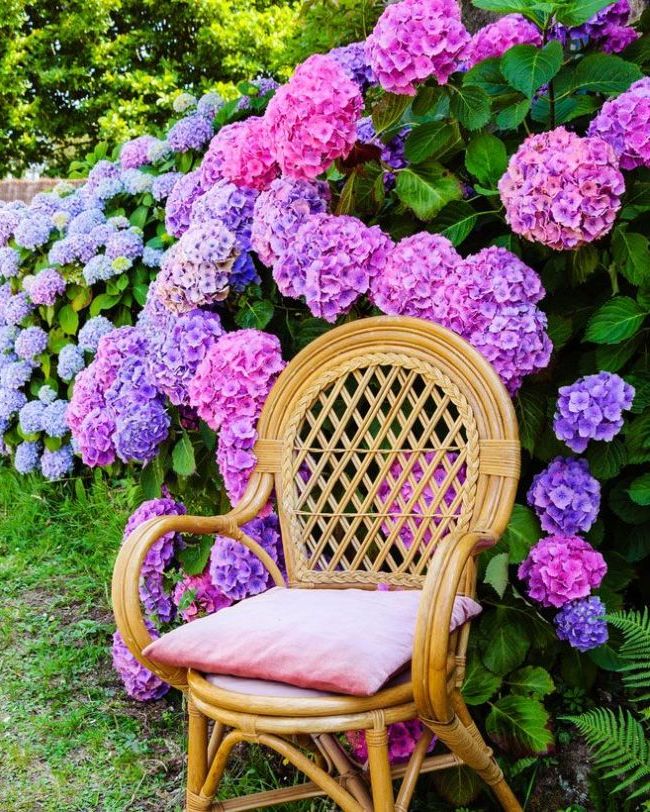
- Daboliste- The leaves in shape resemble oak, grows up to 2 meters, the inflorescences of conesoids. By the autumn of the rough foliage acquires purple and burgundy shades. White flowers, near Snow Flake grace.
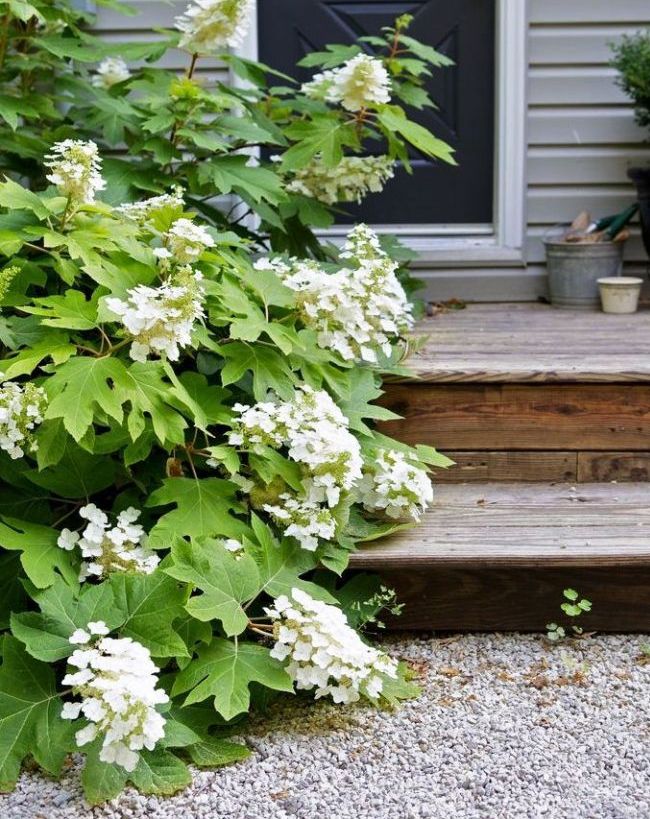

- Garden, large-scale- Bright green leaves of oval shape, slightly pointed, with spherical inflorescences, grows up to 2 m. Flowers, depending on the variety, painted in blue, white and pink shades. Heat-loving, it is necessary to strengthen the winter.
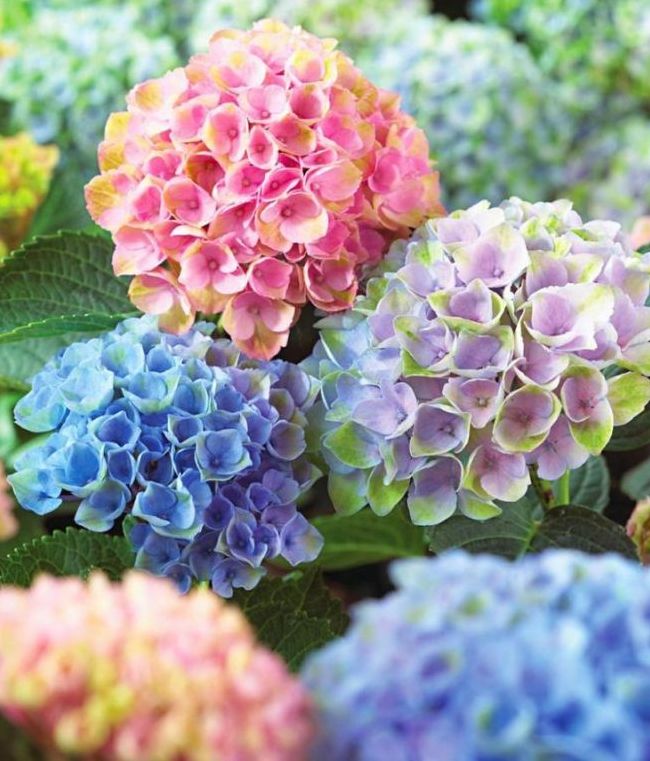

Idea!Another kind is the ash hydrangea - is often used as a living hedge. She has small flowers and dim green leaves.
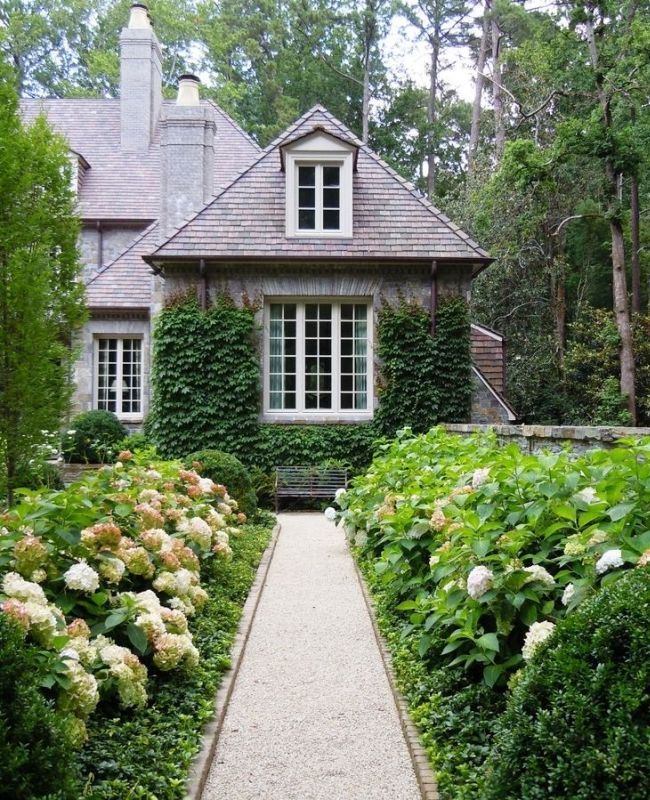
Features of care
Only with the right and most serious approach to the requirements of the plant itself can be predicted with a positive result.

IN correct care The hydrangea includes:
Disembarking
Choosing seedlings, carefully inspect the root system. Ordinary practice - plant landing late spring.
Tip!If the root system of the bush is strongly developed, the landing of the hydrangea may pass in September. For two or three warm weeks of autumn, he will have time to strengthen in the soil and will breathe well.
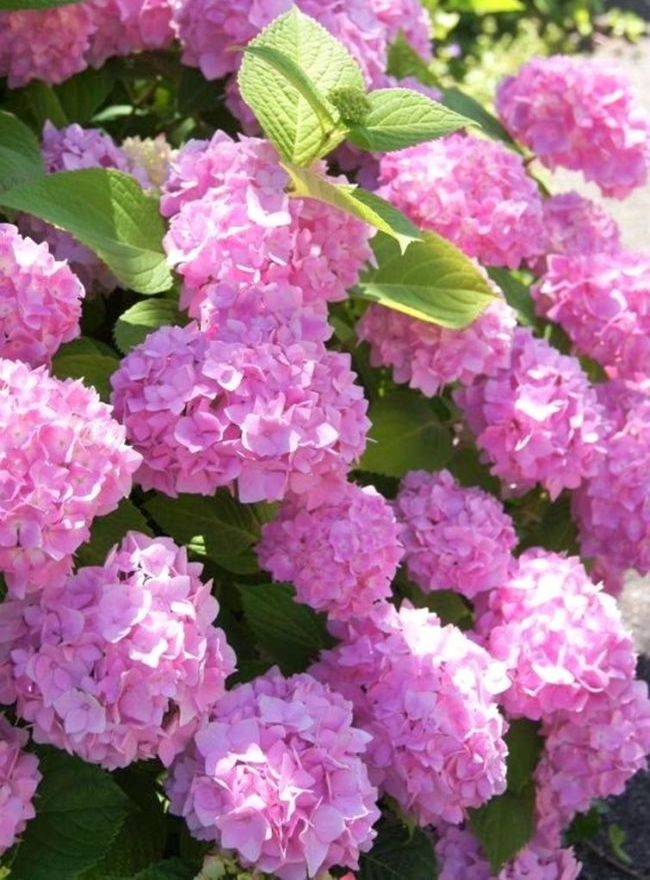
The preparation of the soil under the landing is to make peat with sand and land with a cheese. Drop the pit 50x50 cm, spend drainage. Fill it with the soil, if necessary (if the soil is alkaline), add a fertilizer-acidifier.
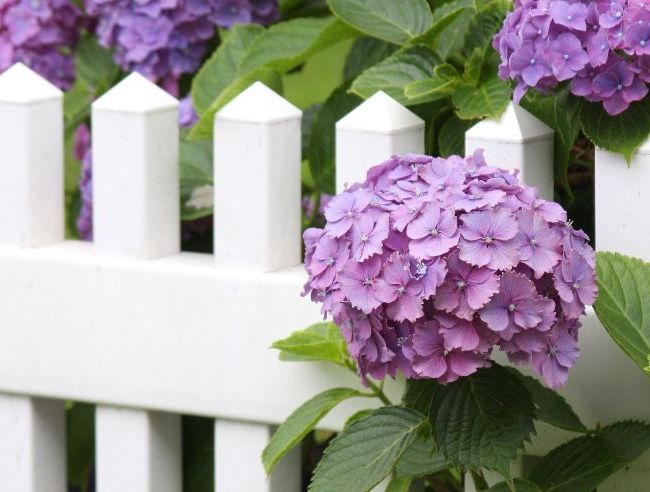
When planting hydrangea in the spring, the rhizomes should shorten and cut one annual shoots, leaving only 3-4 kidney couples. Putting a bush to the soil, pour it, wait until the water is absorbed, and inspired by peat or sawdust with a layer of 6-8 cm.
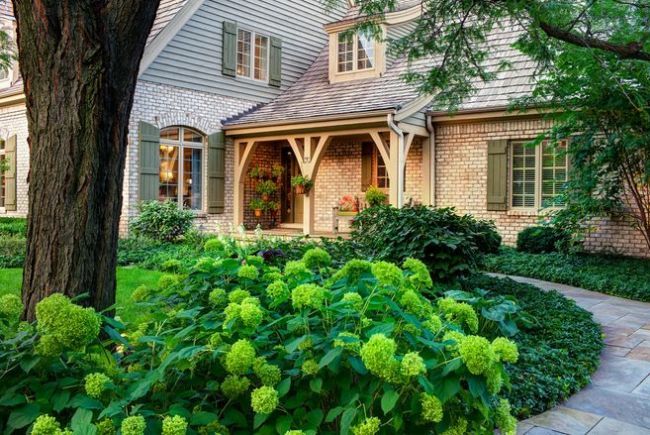
To create a living hedge, seedlings are located 0.7-1 m from each other. If you want to get one but thick and magnificent bush, take 4-5-year-old seedlings for planting 4-5-year-old saplings, breathing a little less depth (35-40 cm) and a width of 50-70 cm.

Trimming
Trimming bushes is a mandatory procedure, whatever type of hydrangea plant. With uncontrolled growth, the bush branches are growing so that they lose their aesthetic appearance. Please note that the first healthy bloom begins at the 3rd year after disembarking, everything that appears earlier, ruthlessly break. It will give an opportunity to the Kuste to develop correctly.
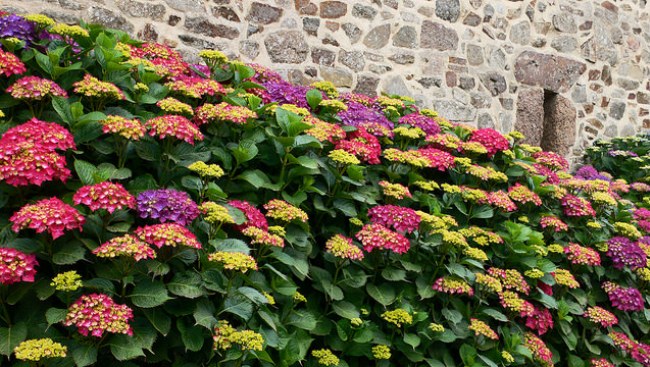
For the already established plants, a spring rejuvenating haircut is carried out, aimed at forming a bush. The procedure is carried out before the start of the plant in the plant. If you have noticed that the inflorescences of hydrangea weaken and decrease in size, cut a bush "on the stump" (when cutting, only the stems of 15-20 cm from the ground are left). The plant moves well such a cardinal manipulation and quickly grow up, returning the pomp flowers.
Slaft trimming is necessary for alive hedges from hydrangea. Do it on your own discretion, but not earlier than the bushes will come to force.

Tip!Do not ridge the inflorescences manually, cut them with a neatly secateur so as not to affect the top of the branches with the kidneys.
Watering
The thermal-loving flower hydrangea loves moisture. It is important that the soil under the bush is always in a state of mild moisture. To do this, it is necessary twice a year to mulch the soil under the plant with the help of needles, sheet humus, chips or bark.
Hydrangea bushes should be watered twice a week
In the fall, in dry days, a plentiful watering is useful to the plant, it will help hydrangea to calmly survive frosts.
Tip!With a mulched peat soil, a rich watering of plants should be carried out less often, approximately 1 time per month.
Safety
Successful cultivation of hydrangea is impossible without competent feeding. After planting, at the beginning of the growth of the seedling, bring superphosphate (30-40 g) under the bush, urea at the rate of 20-25 g per square meter, sulfur potassium (30-35 g).
During the formation of buds, the plant requires additional portions of fertilizers: superphosphate (60-80 g) and sulfur potassium (40-45 g).
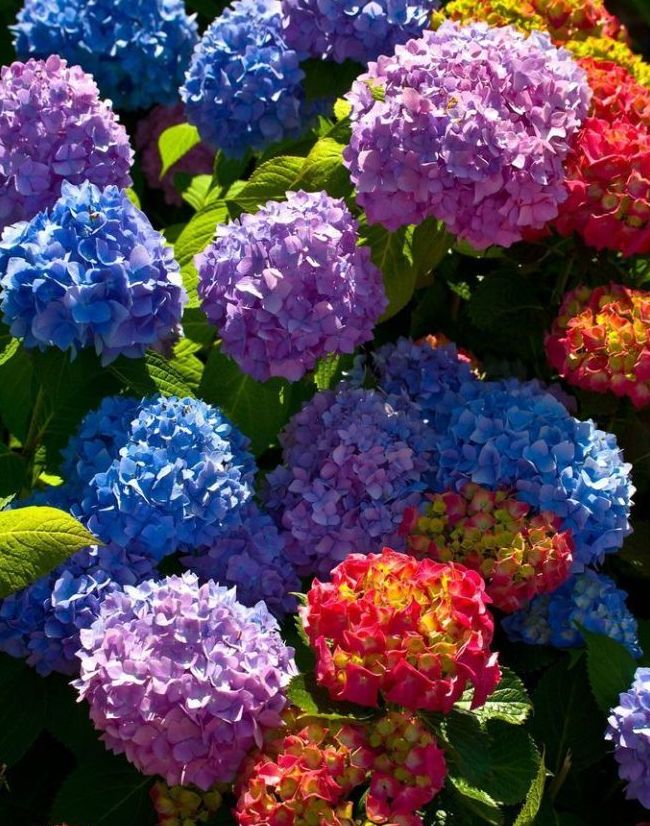
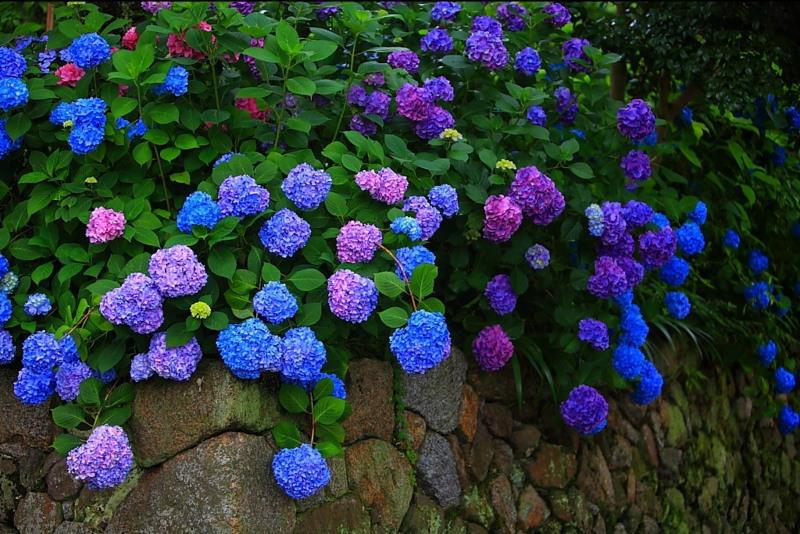
Hydrangees are amazing shrubs in beauty and variety.
1:665 1:675In horticulture, hydrangea is valued for a variety of infusion forms, an extensive color palette, large curly leaves, an interesting bark, as well as for unpretentiousness and abundant flowering. The extraordinarily spectacular sight of hydrangea is represented in the fall, when on one plant you can simultaneously see buds, seed heads and leaves of different colors.
1:1303 1:1313Hydrangea, Latin - Hydrangea, folk - flower-life.
1:1436 1:1440 1:1450The botanical name of the shrub - Hydrangea - only specialists know. Meanwhile, translated from Greek it means "water vessel" and speaks about very an important quality Plants - it loves moisture very much.
1:18541:9

Most species are shrubs Height 1-3 m, some species - small trees rest - liana, closing in the trunks of other trees to a height of up to 30 m.
2:853 2:863Plants can be both leafy and evergreenHowever, the widely cultivated types of moderate belt refer to deciduous.
2:1118 2:1128Flower hydrangea from spring to late autumn. Flowers are assembled at the end of the stem in beautiful spherical inflorescences - a shield or sweat.
2:1372Most species floral heads contain two types of flowers: Small fluster (fertile) flowers in the middle and large fruitless (sterile) flowers at the edges. Some species have all the flowers so far and have the same size.
2:17972:9

In the overwhelming majority of the hydrangea flowers are white, but some, such as hydrangea hydrangea (Hydrangea Macrophyll), they can be blue, red, pink and lilac.
3:849 3:859These species color often depends on the pH level (hydrogen indicator) in the soil: In acidic soils, the petals acquire the blue color, in neutral - pale beige, and in alkaline - pink or lilac.
3:1238 3:1248Hydrangea - one of the few plants capable of accumulating aluminum, which is distinguished from acidic soils and some species forms compounds that give them blue shades.
3:15843:9
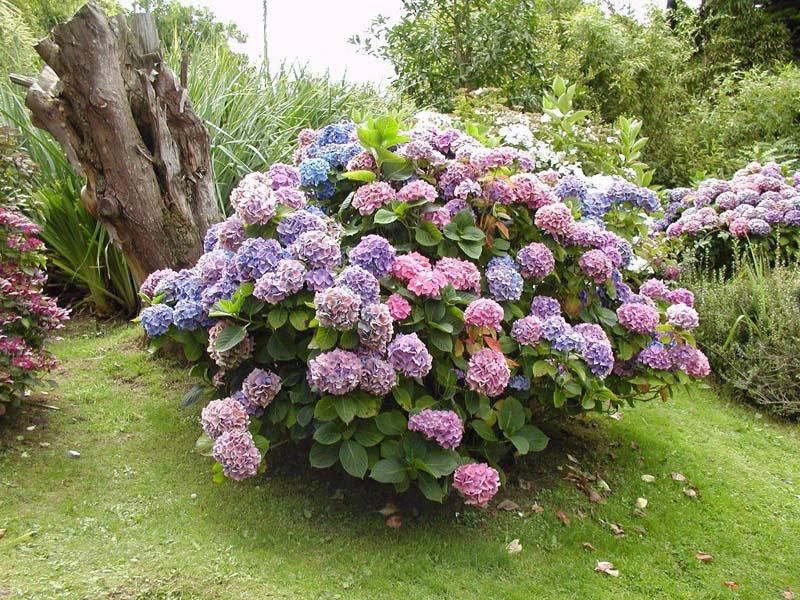
Main types of hydrangea
4:584The total number of species is from 70 to 80, we will list here only the main of them.
4:716 4:726Hydrangea tree (Hydrangea Arborescens).
4:811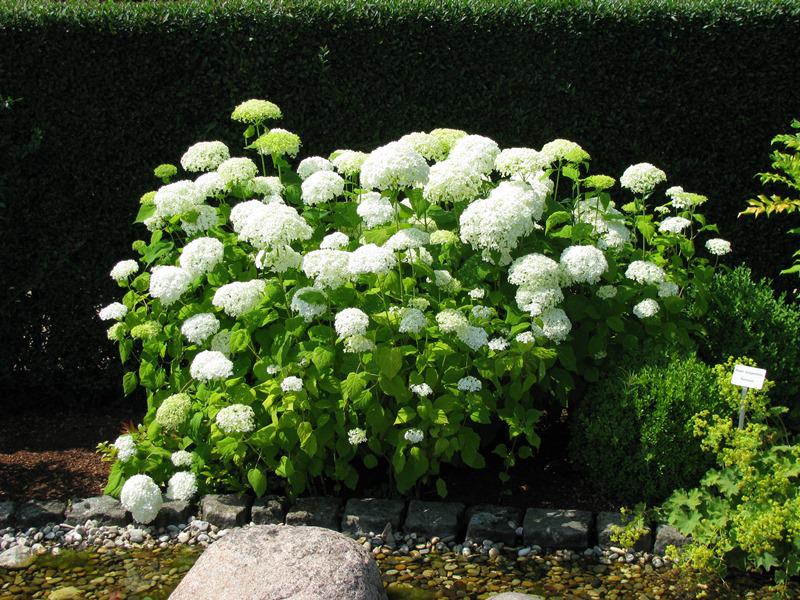
View, in natural conditions growing in the east of North America. White inflorescences. Flowering in July-August. Late in the fall, the blurred inflorescences are recommended to cut. Pruning the extinct, thickened and weakened shoots should be carried out or before the start of the sludge, or after the full blooming of the leaves. One of the famous varieties is Hydrangea Arborescens 'Annabelle' with dark leaves and very large greenish inflorescences.
5:2100 5:9Hydrangea Bretskneider (Hydrangea Bretschneideri).
5:99 5:103 5:113View from China. Large bush tall up to two and a half meters. Leaves are large oval, dark green. Inflorescences - wide shields. Blooming from the beginning of July; At the beginning of flowering, the flowers are white, by the end of July they pose, and in August they acquire a saturated raspberry color. In the context of the European part of Russia, the plant does not require shelter for the winter.
5:743 5:753Hydrangea Macrophylla (Hydrangea Macrophylla).
5:842 5:846 5:856View from South Japan. Leaves bright green, large. Syrene's inflorescences are blown in August. Winter hardiness low; In the context of the European part of Russia, only some particularly cold-resistant varieties do not sweat, - for example, Hydrangea Macrophylla 'Blue Wave' and 'Endless Summer'. This species is grown as a houseplant.
5:1434 5:1444Miscellaneous hydrangea (Hydrangea Paniculata).
5:1528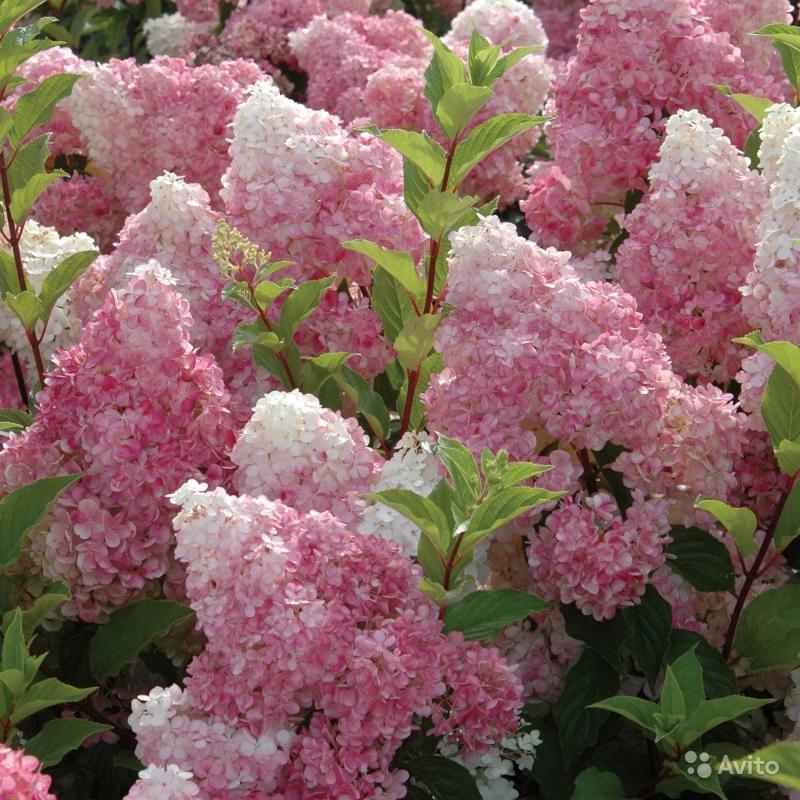
Natural view area - East China, Korea, Japan, Sakhalin. Plants with a height of about one and a half meters. Green buds appear in mid-July, by the end of the month they whiten; bloom - from August throughout the autumn; Inflorescences - with a smooth transition from white to raspberry and crimson with a purple tint. Hydrangea Miscelred has a high winter hardiness. In the fall, trimming of the blurred inflorescences, in the spring - sanitary and forming trimming are recommended. Famous varieties - Hydrangea Paniculata 'Kyushu', 'Pinky Winky', 'Grandiflora'.
6:15096:9
Landing
6:39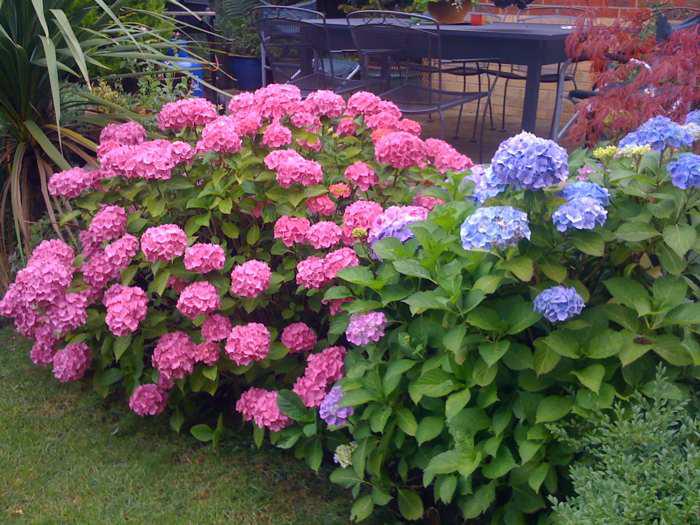
Before planting cuttings of hydrangea of \u200b\u200btree In early April, it is necessary to dug a hole with a diameter of 50 cm and a depth of 60-70 cm. Next, it is necessary to put in the pit of the cuttings and flood with a predetermined mixture, blacklooma, peat and sand in a 2: 2 ratio of 2: 1: 1. It is also necessary to add 20 g of urea and 30 g of potassium sulfate and superphosphate. Repeat such a complex feeder in 2 years.
7:1278 7:1288Undercantling with mineral fertilizers or manure can be carried out at the beginning of growth, during the formation of buds and 1-2 times in the summer, smaller doses. Plant to plant at a distance of about 150 cm from each other. Do not place a plant next to the trees, as they actively absorb moisture from the soil.
7:18567:9
It is not required for the winter. Thanks to the powerful root system, in case of freezing, the plant is restored to the previous state. Blooming starts for 4-5 years.
7:310 7:320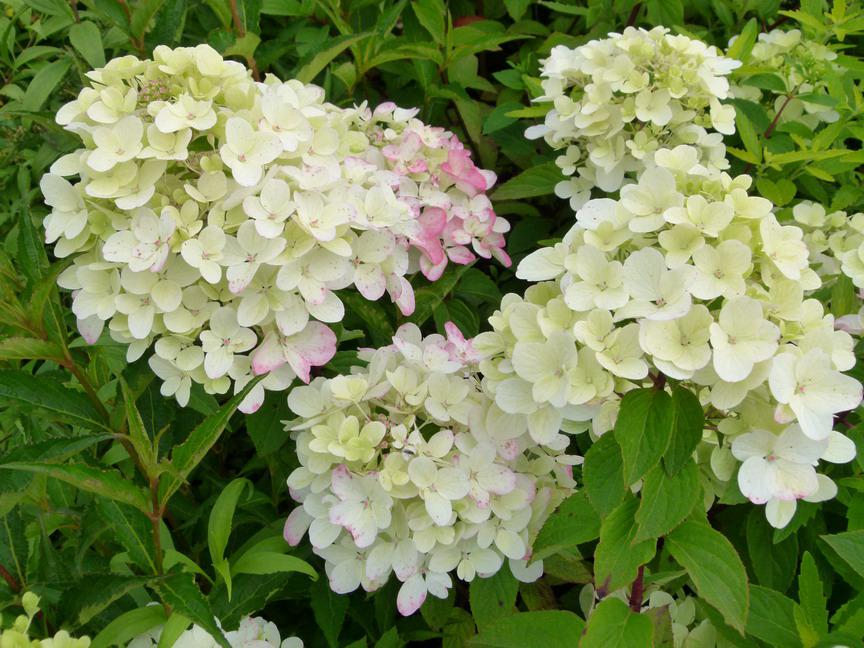
Saplings of hydrangea Mettelstea Permanent place is planted in 4-5 years. For this, they prepare a hole with a depth of 35-40 cm, 50 x 70 cm wide. And for the free living hedge, they jump up the meter strip. The distance between the adult plants should be up to 2.5 m, but in order to have a "bouquet" before, the pits are marked after 0.7-1 m, and after several years, the group is thinned. In the northern regions, hydrangea is better to plant in spring, in more southern - in spring and autumn.
8:1648 8:9Slightly shortening the roots, and if the case occurs in the spring, then all annual shoots, leaving on every 3-4 pairs of kidneys. The planting is mounted in a peat, a compost layer of 5-8 cm. From autumn feeding with mineral fertilizers, and early spring - urea solution at the rate of 18-20 g per bucket, 2-3 buckets per plant.
8:600 8:610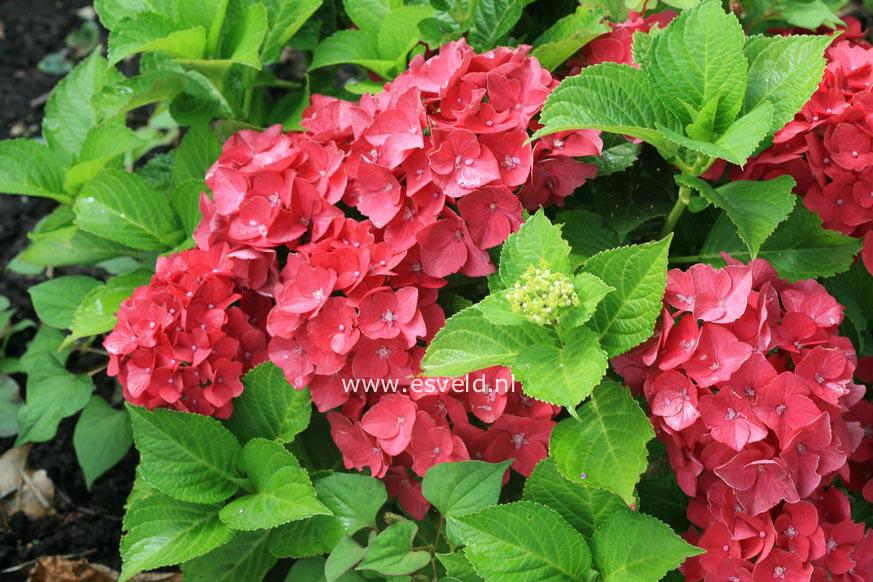
Hydrangea hydrangearegarding light-friendly, but it can be planted in a light half-haul, but the smaller the light, the later bloom and the less inflorescence. Soil is preferable to a weakly or secondary (pH 5.5); One of the compositions: Sheet, Cherry Earth, Peat and Sand in a 1: 1: 1: 1 ratio. On alkaline soil, hydrangea suffers with chlorosis (the leaves begin to shine). In order to avoid chlorosis, once every 10 days is carried out by irrigating salts containing iron.
9:20059:9 10:514 10:524
Depending on the acidity of the soil, you can change the color of flowers. With a weakly alkaline medium reaction, they are pink, with sour change the color on blue or blue. To obtain blue and blue inflorescences, it is necessary to make in the soil every two weeks of iron and alum salts: 3-5 alumokalia or ammonia-potassium alum on 1 liter of water. For one plant it is necessary 2 liters of such a solution.
10:1199 10:1209 10:1213 10:1223To accelerate flowering, the plant is sprayed twice with aqueous solution of gibberlines with an interval of 4-7 days at a concentration of 50 mg / l. Then hydrangea blooms 2-4 weeks earlier. This reception increases the decorativeness of plants. Flowers become larger, and there are more of them. Plant treatment is carried out when they reach 2-4 cm. It grows quickly, thermal-loving, demanding of soil and moisture, does not tolerate lime. Mint with a small shading, a small-resistant (up to -18 ° C).
10:210510:9
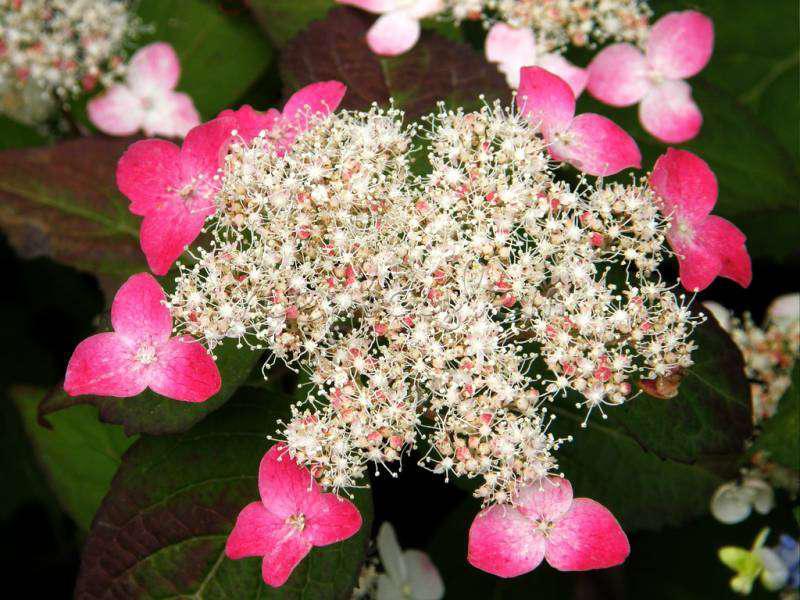
Hydrangea Pilly Miyama-Kuro-Hime
Easily breeds the division of the bush and green cuttings. In Russia, hydrangea largest is growing in the open ground only in the south. When cultivating in a greenhouse or in the room at the very end of the vegetation, when the hydrangea begins to reset the leaves, the shoots must be short to cut. In winter, during the rest of the plants hold in a cool, but non-freezing room (+5 ° C), and at the end of winter, when the kidneys swell, tolerate into a leaper and bright room, but without direct sunlight. Also, this species can be cultivated in the form of a container culture, which is located outdoors only in the summer season.
11:171711:9 11:13 11:23
Recently, with the development of agricultural engineering and climate warming, hydrangea laminated has begun to cultivate in the open ground of the middle strip of Russia. Sadovaya hydrangea inflorescences are formed on last year's shoots. Therefore, the main problem is to maintain them entirely so that the flower kidneys do not extinate and do not up.
11:613 11:623 11:627 11:637Shelter methods are the same as for roses. Among the varieties of hydrangea Sadovaya have more winter-hardy varieties And those that can be grown in the middle lane of Russia only with the enhancing plants for the winter room. Even relatively winter-resistant hydrangea varieties of garden due to the features of the microclimate can grow and bloom far from all areas.
11:1263 11:1273
The bushes of hydrangea hydrangea are better tolerant of frosts, if a sufficient amount of moisture was obtained in the fall. Flowers and leaves large hydrangea Even with weak night frosts, so it is recommended to cover them in the second half of October. Cover the bushes from short-term frosts can be undermined by material and greenhouse film, be sure to two layers. For the winter, the plants are plunged at the base of peat, the branches are thrown into the ground and fall asleep with dry leaves, sweetheart.
12:906 12:916
The soil
13:1457For successful abundant flowering, fertile soils are necessary. Hydrangea prefers clay structural soil, grows on the red, but the sandy does not like.
13:176213:9
By the way, the coloring of flowers becomes brighter at the hydrangea of \u200b\u200ba scattering, growing on acidic soil, and on neutral not only pale, but the whole plant has to be tight. Therefore, if the soil on the site is not sufficiently sour, when landing it is necessary to add brown peat, coniferous ground (spruce, and better pine semi-proverse OPEAD), sawdust. Ash, lime, chalk and other deoxidizers for all hydrangeas are contraindicated. The root system lies shallow. The roots predominantly apply to the width, and as a result of their border significantly exceeds the crown border.
13:1027 13:1037For normal vital activity, they need wet soil. A good solution can be a landing in the priority circles of soil plants, for example, the camneur of mossoid, various successes.
13:1409 13:1419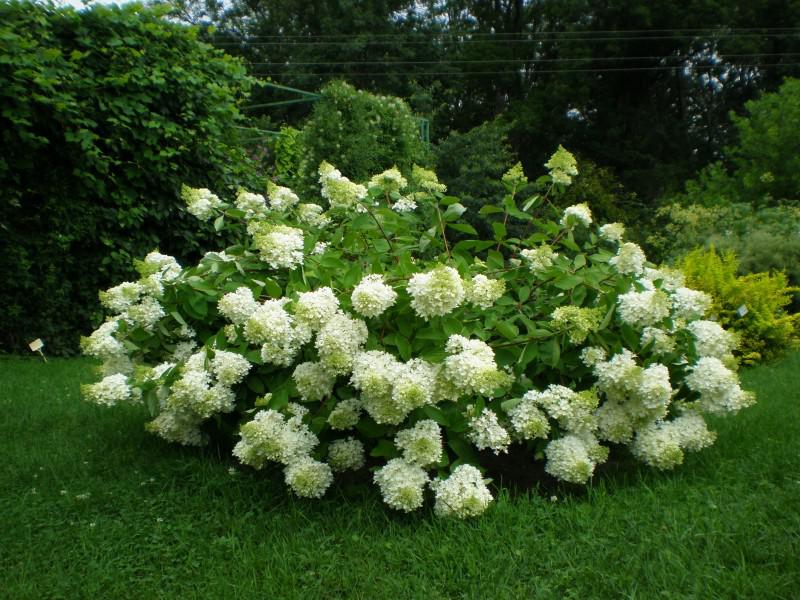
14:9
Growing conditions
14:62Hydrangea is multiplying mainly herbaceous cuttings from roasting shoots. The cuttings from side shoots give plants weaker, so they are avoided.
14:360 14:370Hydrangea shilling in the house large in the house is carried out in February-March (even until April 15). Hydrangea, rooted in February-March, can be grown in 4 - 5 stems, rooted later should be arranged in one stem.
14:786 14:796Hydrangea Hortensification Grinding Gain in the Garden is held from June to July inclusive, Before winning shoots. Depending on the presence of laying material, the cuttings are cut with 2-4 nodes with a sharp and clean knife. The cuttings with small leaves are rooted more successful. You need to cut the cuttings before the landing itself. It is impossible to bring the cuttings to withering.
14:1452In the latter case, sipped cuttings should be immersed for a while in water. The leaves are shortened by one third or half.
14:169614:9
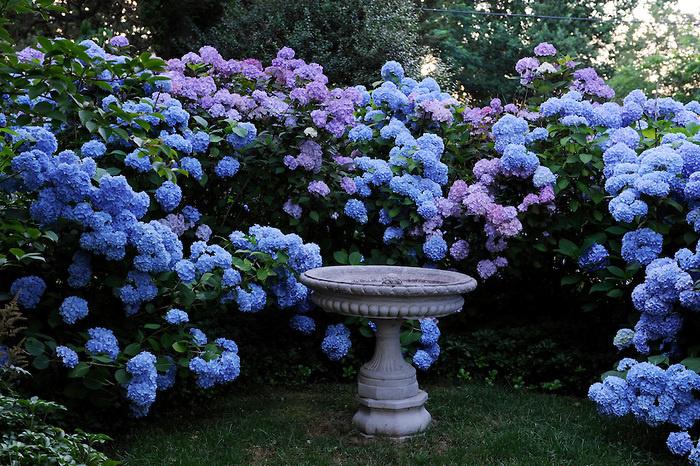
The cuttings are rooted in exploration boxes, on racks, in greenhouses. Nice results It turns out when rooting cuttings in coniferous land; The cuttings are not covered with nothing, but only often spray with water. Strenches for rooting are planting at a depth of 2 cm, but the cuttings of the lower leaves are not immersed in the soil. Distance when landing 4-5 cm.
15:1112 15:1122After landing, they should pour them, bearing in mind that the faded cuttings of Hydrangees are difficult to restore the turgor and are rooted worse. The wilt of the cuttings is very often the cause of poor rooting. Hydrangea must be shade from bright sunlight. Some flowerflowers root the cuttings of hydrangea under the glass, but this method often causes the drainage of the cuttings.
15:1793 15:9The temperature in rooting is supported by about 14-17 ° C. The lower temperature lengthens the level of rooting, and, therefore, provides more opportunities to rotate cuttings. When grilling hydrangeas, you need to comply with cleanliness.
15:455 15:461 15:471The rooted cuttings (for this it is usually required 15-20 days) searched in boxes or on racks at a distance of 8 × 8 cm or in 7-9 centimeter pots.
15:745Growing hydrangeas in pots uneconomically: More space and labor costs are required. Soil for hydrangea cuttings should be an acidic, consisting of swamp and compost land. If the compost land does not have acidity, then use peat. For white, pink and red hydrangeas, weakly acidic soil is recommended (pH 5-6), for blue and lilac - more acidic (pH 4-4.5). With insufficient acidity, the leaves in hydrangea are yellow. In order to avoid this, the soil is watered with a weak solution of sulfuric acid (5 g per 100 liters of water).
15:169015:9
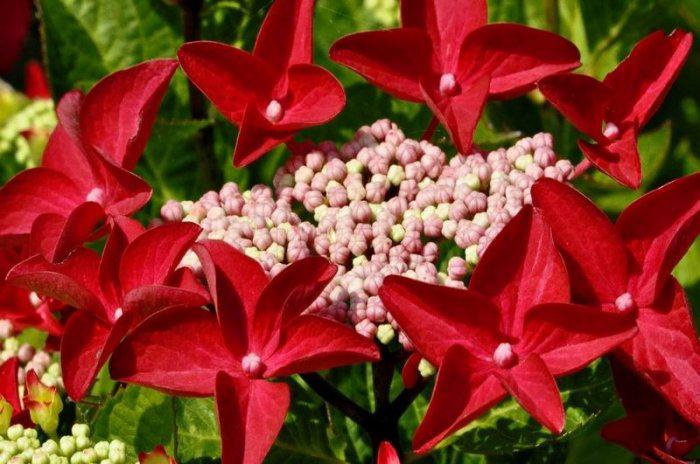
Planting plants in boxes or racks makes facilitated plants, they grow better and develop. The cuttings are watered with water that does not contain lime neutralizing soil acidity. It is impossible to use not completely overwhelmed manure, which can cause the yellowing of the leaves. The same phenomenon may occur from an excess of lime in the soil, since in sufficient acidity of the soil of hydrangea will not be able to absorb potassium, magnesium, iron.
16:1319 16:1329It is advisable to prepare the soil of the previous autumn or at the beginning of winter, To applied fertilizers can decompose enough. On 1 m3 of the soil add 2 kg of bone flour, 0.75 kg of potassium sulfate, 1.5 g of ammonium sulfate. Tomasshlak and other fertilizers with an alkaline reaction are not recommended.
16:188416:9
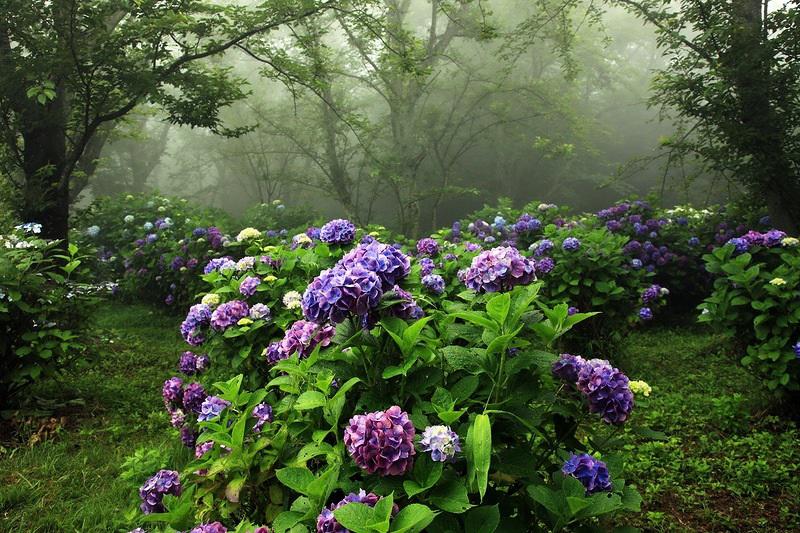
Rooted plants in spring feed every week Full fertilizer with a predominance of nitrogen fertilizers. Temperature should be about 14 ° C. In May, drawers with hydrangeas are transferred to cold greenhouses. Early grades with a short period of growth, which faster form floral kidneys are cut into the first half of June, and the late varieties in May. Pruning makes over two pairs of normally developed leaves. These plants will have 3-4 escapes.
17:1338 17:1348Do not cut the late shilling plants, Since they usually bloom with one cap. To get low indoor plants It is necessary that they do not stretch. Cutting the tops of plants are rooted to obtain single-layered plants. Two weeks before trimming or two weeks after it, the plants are planted in pots in which they should bloom.
17:200017:9
Stretched hydrangea when planting pots plant deeper than they satto reduce their height. Hydrangees form roots even on the weird stems.
17:305 17:315 17:319 17:329Single-way plants plant a diameter of 10-12 cm with a diameter of 10-12 cm, and a two-four-sieved - in pots with a diameter of 12-14 cm. The first time of the plant in the greenhouses after planting is dialed from bright sunlight. After rooting the plant in the shading do not need: it can even lead to the stretching of plants.
17:879 17:889Plants still faintly rooted in pots, you need to protect from heavy rains, so they do not immediately bring out of the greenhouse for the ridge open soil. All weak shoots from the hydrangea are cut out, since only large colors caps are considered decorative.
17:1351 17:1361Hydrangea - moisture-boring plants, so they need to water and spray them in a timely manner. To obtain decorative plants, hydrangea is systematically fed by alternately with a cowber and a mixture of mineral salts. The early grades of Hydrangees finish their growth by August, therefore, they are stopped from this month to feed and reduce watering, and subsequently, even somewhat dried to ripening the kidneys. Late varieties finish growth for a month later, after which they are also crowned less often.
17:2293 17:9 17:13 17:23During the ripening of the kidney, the plants spray so as not to cause strong fading. In early September, the hortensia of the early grades give precomply feeding, which brings the timing of flowering. In winter, plants are better to contain in cool greenhouses, basements, greenhouses.
17:524 17:534In case of insufficient light, the temperature in the room of the greenhouse should be about 2-4 ° C. So that hydrangea blooms in December-January, it provides additional electric lighting from October. Additional lighting lighting makes a lot of flowering offensive.
17:1048 17:1058Hydrangees put under lamps with incharpasses and give additional lighting in winter for 8-10 hours. The best result is observed with night lighting. It accelerates bloom for 7-20 days. Day lighting gives a smaller effect.
17:150617:9
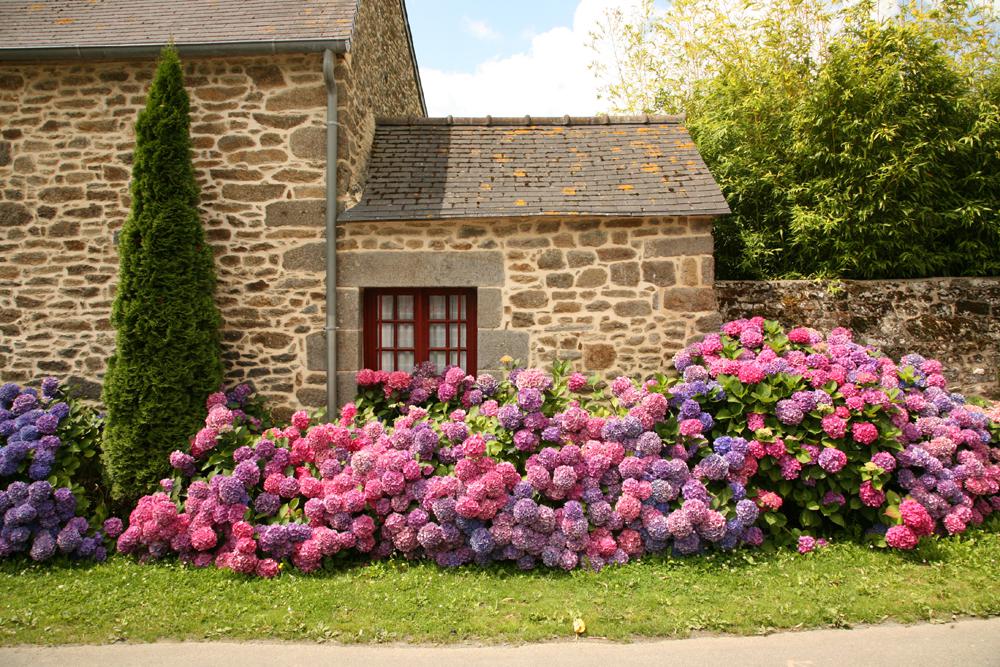
Subject to the good natural light of the greenhouse the earliest suspension of growth produced in november-December For blooming only in early March. For this use early varieties with well-affected kidneys. With a lack of light, plants are grown at a relatively low temperature of about 10 ° C, lengthening the time of blooming.
18:1154 18:1164Warm baths are used to accelerate the blooming of hydrangea: Plants are kept in water at a temperature of 35 ° C for 12 hours. After the bath, the hydrangea is placed in the greenhouses with a temperature of 15-16 ° C.
18:151818:9
Good results also gives double spraying of plants at a temperature of 12-14 ° C heteroacusin (100 mg of heteroacusin per 1 liter of water). With the advent of the leaves of hydrangea, they begin to water more. On sunny days, the temperature in the greenhouse can rise to 20 ° C. At this time, you need to carefully monitor the plants to be quite well provided with moisture. In the greenhouse, hydrangea should be free, without shading each other.
18:794 18:804
With the appearance of hydrangea buds, weekly feed the influence of the cowboy and a solution of mineral mixture with a predominance of nitrogen. The surface of the soil in pots should be disappeared. When flowers are formed, hydrangea is tied up to spicks. To obtain exhibition bushes of hydrangeas with large and abundant colors, you can apply the following method.
19:198619:9
Old hydrangea, cropped by 25-30 cm from the ground, plant in the ground so that the root neck is closed by the earth. For the winter, the plants bent to the ground are covered with a spruce vegetable, dry leaf, etc. Spring old stems are cut to base. During the summer, multiple bushes are formed. Plants are abundantly watered.
19:588 19:598 19:885 19:895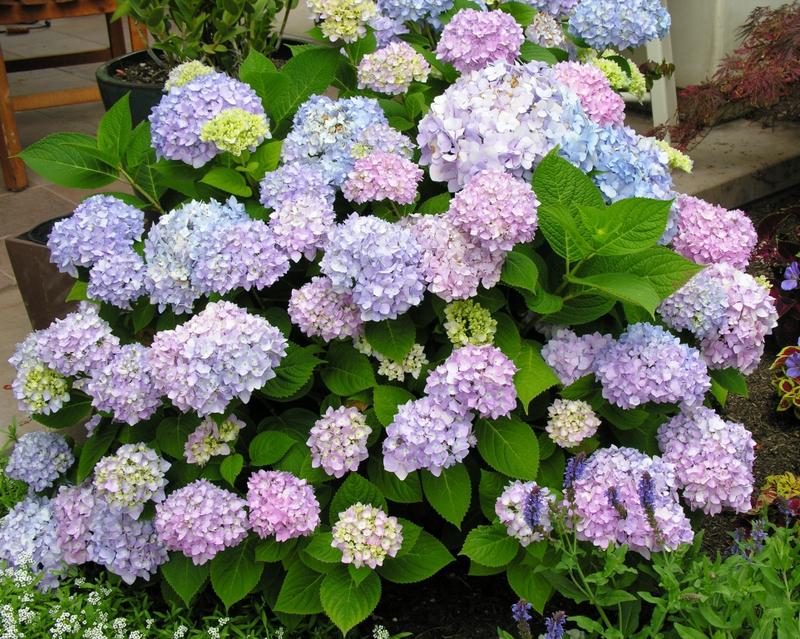
For 5-6 years, you can grow perpetary hydrangeas with several dozen umbrellas. It is necessary to take the large diameter of the pots with an increase in the number of shoots: at one shoot - a diameter of 10 cm, with two or three shoots - a diameter of 12-13 cm, with a larger number of shoots take pots with a diameter of 15-18 cm. Hydrangea typically has pink flowers. However, in some localities, peat and heather soils cause the formation of flowers. This phenomenon may be caused by the use of conventional alum (25-30 g by 10-12 liters of water), aluminum and iron sulfates. But not all varieties of hydrangea change the color of flowers in blue.
20:2523 20:9The best grade for this purpose is the blue prince. Suitable soil for obtaining hydrangeas with blue colors is a turden land with swampy meadows. The presence of iron and aluminum in this soil gives the blue color of hydrangea flowers. Watering the alum with a solution start 2-2.5 months before flowering.
20:537 20:547Care for hydrangea
20:598

Lighting: Bright scattered light. In summer, it is possible to endure in the garden, gradually catching up to the direct sunlight, and then when the plants are accustomed to, the pots are bored in the ground and leave until autumn.
21:1463 21:1473Watering: Abundant from spring to autumn. Hydrangees like them when they are watered with some drying of the Earth in the pots, but not allowing the drying out of the entire earth coma. Poor tolerate hard water.
21:182321:9
Air humidity: From time to time spray.
21:104 21:114Feeding: Historifier feeders are carried out with liquid mineral and organic fertilizers after watering. Feed in summer and at the end of winter before flowing. After trimming before the appearance of new shoots, they do not feed.
21:524 21:534Circuit: After flowering afternoon.
21:623 21:633
Diseases and pests
22:1207Cobbled tick.It strikes the leaves from the bottom side, causing their yellowing and marble color, then drying and fond. With an optimal temperature for a tick (29-31 ° C) and humidity (35-55%), its development cycle flows 7-9 days. The tinger covers the bottom side of the leaf of the brown cobweb. For the year it gives 12-15 generations. Under reduced temperature (10-1 12 ° C) and high humidity (80-85%), its activity is significantly reduced.
22:196122:9
Measures of struggle: Spraying of plants by thiophos (5-7 g per 10 liters of water).
22:126 22:136
False powdery dew.Amazes leaves and hortenside stems. Its first signs are the appearance on the leaves of oily, later yellowing spots, gradually darkening and increasing in size. From the bottom of the leaves, a yellowish flare appears, the same flare can be on young stems. The development of the disease promotes the temperature 18-20 ° C and high humidity.
23:1324 23:1336Measures of struggle: Processing of affected plants with a copper liquid (150 g of green soap, 15 g of copper mood for 10 liters of water). This liquid is harmless to plants, and its use in the early stages of development helps to completely get rid of the disease.
23:179223:9
Chlorosis. The sign of chlorosis is the clarification of the leaves, only the accommodation remains dark on them. More susceptible to chlorose plants growing on soils with a significant amount of lime. Overbupping in the soil Humidity also leads to chlorosis disease.
23:485 23:495Measures of struggle:2-3 times the solution of potassium azotic potassium at the rate of 40 g per 10 liters of water and after three days - a solution of iron vitriol, also 40 g per 10 liters of water.
23:782 23:792 24:1297 24:1307Sheet fabric In the conditions of closed soil, when the plants are reversed, hydrangea may affect the green leaf floss.
24:1521 24:9Measures of struggle: good to a tool Its destruction is a double spraying of plants with a solution of anabazine sulfate. For this, 15-20 g of sulfate anabazine is dissolved in 10 liters of water. This serves as a radical means in the fight against a leaf tool.
24:443 24:453
How nice in the garden to have such a motley set of these wonderful colors! But the most pleasant thing is that hydrangea is not too complicated in care and autumn will be able to please you with an abundance of juicy paints and forms.
25:1322 25:1332Appearing in Europe in the eighteenth century, Hortensia immediately became a star of gardens and oranges. Gentle heat-loving bushes brought from Japan, holly and cherished, admiring the lush inflorescences. The active work of breeders of England, France and Germany allowed hydrangea to flood European gardens, becoming more frost-resistant, having received a more diverse color color and more simple care.
An interesting feature of hydrangea is its property. change color color depending on the acidity of the soil. Blue shades are manifested only on soils with an acidic reaction. The same plant lined with alkaline ground will become pink.  Watering with special mixtures that change the acidity of the soil, makes it possible to achieve the desired color of hydrangea. Such care is easier to implement in pot culture.
Watering with special mixtures that change the acidity of the soil, makes it possible to achieve the desired color of hydrangea. Such care is easier to implement in pot culture.
The hydrangee family has more than 70 species that differ in the shape and size of inflorescences, the height of the bush. There are evergreens, curly, dwarf, which are used for greening parks, private gardens and vegetable gardens. Hydrangea care is easy.
Rules of cultivation
Most of the hydrangea varieties have similar requirements for growth conditions, with the exception of frost resistance and shadowability. Knowing how to care for hydrangeas, you can choose a variety for your climatic zone or try to create special conditions for the plant you like.
The soil
For hydrangea need air-permeable soilwhich retains moisture well and has a weakly acidic reaction. Improve its quality will help add peat and humus. To increase frost-resistant and more abundant flowering, potassium fertilizers in the form of potassium sulfate should be added. Making nitrogen, on the contrary, reduces frost resistance.
If you want your hydrangea to have inflorescences in blue and blue colors, the soil must be more acidic and contain iron and aluminum. Low acidity close to neutral and high phosphorus content leads to the appearance of pink-red shades in inflorescences. On white coloring such care does not affect.
Illumination and temperature
On sunny areas of hydrangea can grow only with sufficient soil moisture. For most types of preferred easy shading.
The frost resistance of various species varies from very hardy, carrying frost to -40 ° C, to completely intolerable frost. For many species, there is enough easy shelter for the winter, some need more serious protection. Self gentle varieties can be grown in containers, providing special care and pulling out an open air in the warm season.
Watering
All types of hydrangeas require regular watering, especially on dry sandy soils and with bright sunlight. Moisture should always be a lot the soil of the roots is desirable to cover the layer of mulch. This is the main care for hydrangea. Dry weather is well tolerated only by buggy hydrangea.
Trimming
After flowering, dried flowers retain their decorativeness up to spring, so they are not cut. Since the flowers appear on the shoots of the current year, hydrangees trimming in early spring. Dry inflorescences are removed to the first pair of strong kidney. A shorter trimming can cause weak flowering. Strong trimming requires only the hydrangea hydrangea. If the shrub is too thickened, remove the old, weak and curves of the root branches. Pruning is carried out annually.
If you neglected regular trimming, after a few years, the shrub is very thickened, the inflorescence becomes less, their size decreases. At the same time, the decorativeness of landings is suffering, hydrangea has an untidy neglected look. In order for new shoots to give a powerful increase, the right care is needed, plants feed fertilizers.
Young, just planted bushes do not need severe trimming, only damaged and weak branches should be removed. The next spring branch is shortened by 1/3. More adults plants cut off depending on the variety. In high fast-growing plants, the branches are trimmed stronger than the lowest. Old bushes can be rejuvenated by conducting severe trimming to old wood, such a care will allow to get blossom a year.
Popular species
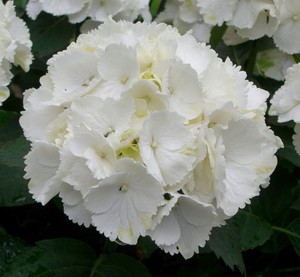 Hydrangea Macrophylla (Hydrangea Macrophylla) is the very kind that the first won Europe. Its large bushes covered with bright green leaves and large inflorescences are a real garden decoration. Inflorescences may have all sorts of coloring of various shades of blue, pink and white colors. There are varieties with yellowish leaves and with an unusual coloring stems. Hortensia of this species feel bad on the bright sun and we need half youth. For them, timely abundant watering is very important. To obtain a blue color of flowers, they recommend mulching with leaf power, firing cheeis and peat, in addition, aluminum alums are used for irrigation to 1 liter of water. For the winter requires shelter and more other species need care.
Hydrangea Macrophylla (Hydrangea Macrophylla) is the very kind that the first won Europe. Its large bushes covered with bright green leaves and large inflorescences are a real garden decoration. Inflorescences may have all sorts of coloring of various shades of blue, pink and white colors. There are varieties with yellowish leaves and with an unusual coloring stems. Hortensia of this species feel bad on the bright sun and we need half youth. For them, timely abundant watering is very important. To obtain a blue color of flowers, they recommend mulching with leaf power, firing cheeis and peat, in addition, aluminum alums are used for irrigation to 1 liter of water. For the winter requires shelter and more other species need care.- Miscellaneous hydrangea (H. Paniculata) has a beige pyramidal inflorescences that gradually become pink by autumn. This plant has a very powerful growth and per year can give up to two meters of increment, therefore needs a strong annual trimming. May grow into a large tree up to 10 meters high. From summer to late autumn, the hydrangea is covered with flowers and has a very decorative look. She is very worn, frost-resistant and grows long in one place, without requiring special care, which makes it a valuable plant for urban landscaping.
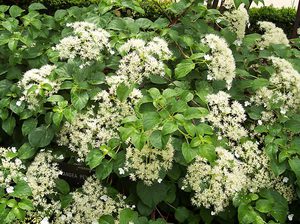 Hydrangea is cherry (H. petiolaris) - a curly shrub, capable of climbing the support to a height of up to 25 meters, using tenacious air roots. In nature, the trunks of trees will deteriorate, so he loves her half. If it does not find a suitable support, it grips on the ground. Hydrangea is cherry - beautiful honey. It looks wonderful against the background of plants with dark leaves.
Hydrangea is cherry (H. petiolaris) - a curly shrub, capable of climbing the support to a height of up to 25 meters, using tenacious air roots. In nature, the trunks of trees will deteriorate, so he loves her half. If it does not find a suitable support, it grips on the ground. Hydrangea is cherry - beautiful honey. It looks wonderful against the background of plants with dark leaves.- Hydrangea Pilly (H. Serrata) is distinguished by umbrella inflorescences, the diameter of which is about 15 cm. This is a light-loving shrub growing up to 1.5 m height requiring abundant irrigation. This plant requires good fertile soil, for which generously thanks long-term abundant blossoms.
- Hydrangea Tree (H. Arborescens) has a height of up to 2 meters. Her inflorescences are large white balls. This is a good honey. The plant is moderately frost-resistant, when frosting is rapidly restored. It grows well in bright places on fertile, well-moistened soils. It has excellent decorative qualities.
- Hydrangea is radiate (H. Radiata) - a shrub tall up to 2 m. A distinctive feature is a silver shade of leaves. Plumbing inflorescence white color They have a diameter of about 12 cm and decorate the plant from July to August. Prefers acidic soils, well-lit places, makes a slight shading. Requires the shelter of the root system for the winter of foliage or land. When frosting is well restored.
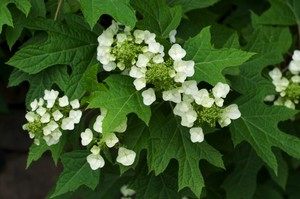 Dorisal hydrangea (H. quercifolia) has rough leaves, shape resembling oak. Its growth reaches 2 m. It has cone-shaped inflorescences of white. Very decorative autumn color of foliage, having shades from burgundy to purple.
Dorisal hydrangea (H. quercifolia) has rough leaves, shape resembling oak. Its growth reaches 2 m. It has cone-shaped inflorescences of white. Very decorative autumn color of foliage, having shades from burgundy to purple.- Hydrangea Bretenneeter (H. Bretshneideri) Large leafy shrub up to 4 m high and up to 3 m in diameter with very large dark green leaves. Excellent option for living hedges, since the plant is frost and drought-resistant. Autumn painting of yellow-brown leaves. Inflorescences of palate, blossom abundant and regular.
- Sergeent's hydrangea (H. Sargentiana) is characterized by very large inflorescences of up to 30 cm, consisting of a rings of pink flowers surrounding a purple middle, and velvety dark green leaves. The height of the bush is up to 4 m. Blossom comes at the end of summer. He is a good honey.
 Room Hydrangea, grown in the pots, will become an excellent decoration of the window sill, if it is necessary to care for it. For these purposes, heat-loving evergreen varieties are used. The plant will delight with its bloom from spring to late autumn, in winter, reviving the interior with green foliage. The color of the inflorescence can be the most different - from white and gently blue to red and purple. Very often, the color changes gradually from the beginning of flowering to the end. In the warm period of the year, the pots with hydrangea can be made to the garden or on the balcony, not forgetting the regular watering and shading from the hot sun.
Room Hydrangea, grown in the pots, will become an excellent decoration of the window sill, if it is necessary to care for it. For these purposes, heat-loving evergreen varieties are used. The plant will delight with its bloom from spring to late autumn, in winter, reviving the interior with green foliage. The color of the inflorescence can be the most different - from white and gently blue to red and purple. Very often, the color changes gradually from the beginning of flowering to the end. In the warm period of the year, the pots with hydrangea can be made to the garden or on the balcony, not forgetting the regular watering and shading from the hot sun.
Gorutnesium reproduction
There are several ways to produce new plants. Each of them has its own characteristics. There are such propagation methods:
- pavement;
- obtaining melts;
- division bush;
- seeding;
- graft.
They are distinguished by complexity and complexity, and depend on the variety, as some hydrangeas have sterile flowers and multiply only vegetatively.
Shining
This is the most common method of reproduction of hydrangea. Types of cuttings are:
- spring;
- summer;
- winter.
With the advent of June, spring cuttings are cut with young shoots with a heel - part of last year's growth. Summer July cuttings are harvested from the unwearable part of the branches. Using the tops of the shoots With two interstices, leafy plates are cut to the middle to reduce moisture evaporation.
As a soil, a mixture of peat peat is used in a ratio of 2: 1 or a leaf ground to which the sand layer is poured. Mandatory condition The care of hydrangea is the provision of high humidity - constant watering or artificial fog. The rooting continues three to four weeks. Usually, the percentage of rooted cuttings is very high, especially when processing growth stimulants. In the cold regions, the rooted cuttings are fused in greenhouses, basements or pots, where they are easier to care for the landing at a permanent place in two years.
Hydrangea largest can be multiplying with winter cuttings. For this, the uterine bush is transplanted in the pot and kept at a temperature near zero. In the middle of winter, the plant is transferred to the room with a temperature of about 10 ° C, where two weeks of the kidney begin to wake up. In February, shoots reach the desired size and can be used for rooting as well as summer.
Delivery of bush and grain
Any hydrangea can be multiplied by the division of the bush. For this, in spring or autumn, the bush needs to dig and divide the root in such a way that there are several renewal kidneys on each part. Dellets immediately planted at a permanent place and watered.
To obtain a challenges, last year's escape tilted to the ground and placed in a pre-prepared recess. Part of the escape sprinkle the earth in such a way that several kidneys are covered with soil. The tip of the escape length about 20 cm should be on the surface, and care lies in regular watering. The next year, rooted chain can be rejected. Damage to the shoot in the form of an end in the underground part accelerates the formation of roots.
Sowing seeds
With the help of seeds, species hydrangea breeds. For this, the plot is prepared from the autumn. The garden should be 25 cm above the ground level. It is drunk, bringing peat and compost. Heavy soils require adding sand. In April or May, they begin in April or May, pre-removing all weeds and racing the beds. Seeds of hydrangea do not need any processing. They are scattered manually, and topped with a layer of sand. It is necessary to maintain the soil wet, without giving it to rear in the period of seed germination. Soothes appear in about a month. Tender seedlings require care and careful care - watering, weeding, regular feeding with nitrogen and potash fertilizers.
Hydrangees are an excellent garden decoration both in single landings and in groups with other decorative shrubs, and care for them is completely simple.


